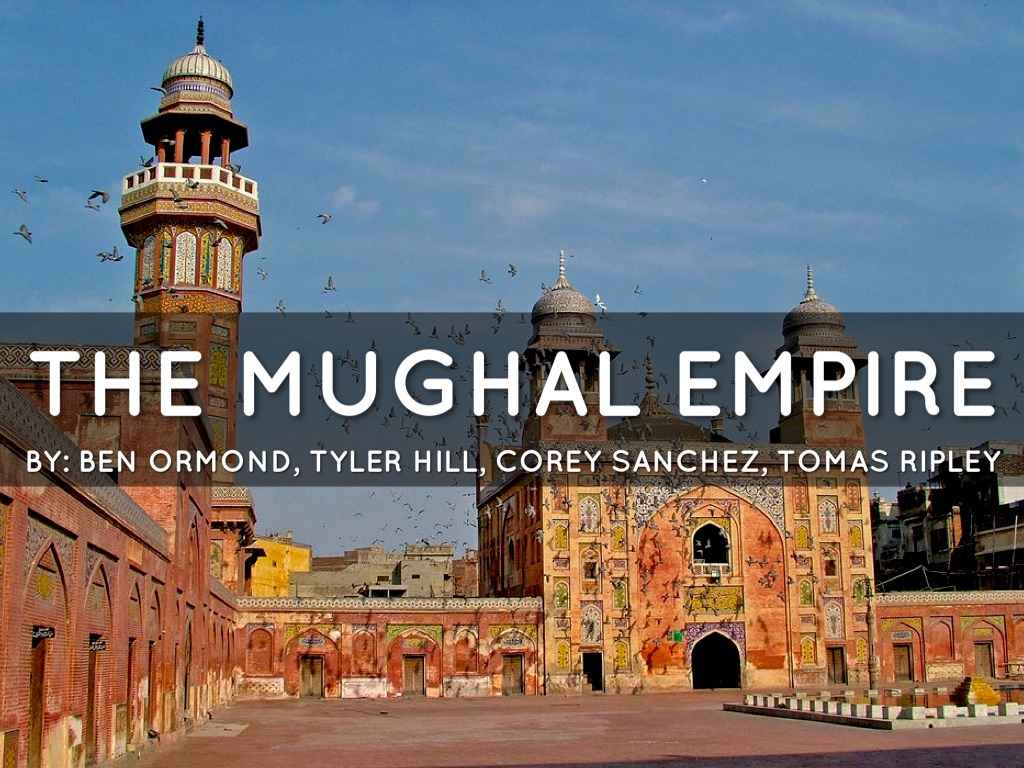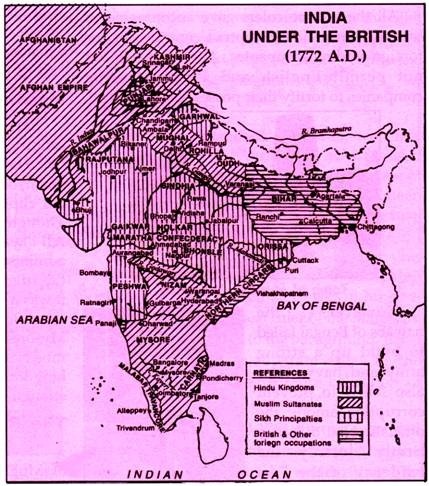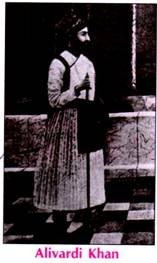Read this article to learn about the decline of Mughal Empire in India!
The history of India, as well as of the world, has been divided into three periods: ancient, medieval and modern.
The death of Aurangzeb is believed to have marked the beginning of the modern period. This history is seen to conclude with the achievement of independence in 1947.
Is ‘modern’ an adequate and acceptable term to describe this period of history?
ADVERTISEMENTS:
Even if we can refer to different historical periods, in which changes occurred and distinguishing characteristics emerged, we cannot fix precise dates for any specific period. Each period was born out of the previous one. But gradually each one developed its own distinctive characteristics.
The idea of the ‘modern’ has come from the West. It is associated with the development of science, reason, liberty, equality and democracy. If we use the term ‘modern’ for the period of British rule in India, we accept that these principles were introduced in India by the British.
An alternate way, then, is to characterise this period as the ‘colonial’. The establishment and spread of British rule, and the accompanying transformation in the political, economic, social and cultural worlds, are all part of this colonial rule.
Decline of the Mughals:
The period of the Great Mughals, which began in 1526 with Babur’s accession to the throne, ended with the death of Aurangzeb in 1707. Aurangzeb’s death marked the end of an era in Indian history. When Aurangzeb died, the empire of the Mughals was the largest in India. Yet, within about fifty years of his death, the Mughal Empire disintegrated.
Aurangzeb’s death was followed by a war of succession among his three sons. It ended in the victory of the eldest brother, Prince Muazzam. The sixty five-year-old prince ascended the throne under the name of Bahadur Shah.
Bahadur Shah (1707 A.D.-1712 A.D.):
Bahadur Shah followed a policy of compromise and conciliation and tried to conciliate the Rajputs, the Marathas, the Bundelas, the Jats and the Sikhs. During his reign the Marathas and the Sikhs became more powerful. He had also to face revolt from the Sikhs. Bahadur Shah died in 1712.
Wars of Succession, which had been a regular feature among the Mughals, had become more acute after the death of Bahadur Shah. This was specially so because the nobles had become very powerful. Different factions of nobles supported rival claimants to the throne in order to occupy high posts.
Jahandar Shah (1712 A.D.-1713 A.D.):
ADVERTISEMENTS:
Jahandar Shah who succeeded Bahadur Shah was weak and incompetent. He was controlled by nobles and could manage to rule only for one year.
 Farrukhsiyar (1713 A.D.-1719 A.D.):
Farrukhsiyar (1713 A.D.-1719 A.D.):
Farrukhsiyar ascended the throne with the help of the Sayyid brothers who were popularly called the ‘king makers’. He was controlled by the Sayyid brothers who were the real authority behind Mughal power. When he tried to free himself from their control, he was killed by them.
Mohammad Shah (1719 A.D.-1748 A.D.):
The Sayyids helped Mohammad Shah, ascend the 18-year-old grandson of Bahadur Shah, to the throne. Taking advantage of the weak rule of Mohammad Shah and the constant rivalry among the various factions of the nobility, some powerful and ambitious nobles established virtually independent states. Hyderabad, Bengal, Awadh and Rohilkhand offered but nominal loyalty to the Mughal Emperor. The Mughal Empire practically broke up.
Mohammad Shah’s long reign of nearly 30 years (1719-1748 A.D.) was the last chance of saving the empire. When his reign began, Mughal prestige among the people was still an important political force. A strong ruler could have saved the dynasty. But Mohammad Shah was not equal to the task. He neglected the affairs of the state and never gave full support to able wazirs.
Nadir Shah’s Invasion:
The condition of India with its incompetent rulers, weak administration and poor military strength attracted foreign invaders. Nadir Shah, the ruler of Persia, attacked Punjab in 1739. Mohammad Shah was easily defeated and imprisoned. Nadir Shah marched towards Delhi. Nadir Shah was a ferocious invader.

Nadir Shah’s invasion gave a crushing blow to the already tottering Mughal Empire and hastened the process of its disintegration. Mohammad Shah’s kingdom was practically confined to Delhi and its neighbourhood. He died in 1748.
Mohammad Shah was succeeded by a number of inefficient rulers Ahmad Shah (1748-1754), Alamgir II (1754-1759), Shah Alam II (1759-1806), Akbar II (1806-1837) and Bahadur Shah II (1837-1857). During the rule of Alamgir II, the East India Company fought the Battle of Plassey in 1757 and defeated Siraj-ud-Daulah, the Nawab of Bengal. They thus got a foothold in Bengal.
In 1761, during the reign of Shah Alam II, Ahmad Shah Abdali, the independent ruler of Afghanistan, invaded India. He conquered Punjab and marched towards Delhi. By this time, the Marathas had extended their influence up to Delhi. Hence a war between the Marathas and Ahmad Shah Abdali was inevitable.
In the Third Battle of Panipat the Marathas were completely defeated. They lost thousands of soldiers along with their very good generals. They were forced to retreat to the Deccan. Ahmad Shah Abdali’s invasion further weakened the Mughal Empire.

Causes of the decline of the Mughal Empire:
1. Wars of Succession:
The Mughals did not follow any law of succession like the law of primogeniture. Consequently, each time a ruler died, a war of succession between the brothers for the throne started. This weakened the Mughal Empire, especially after Aurangzeb. The nobles, by siding with one contender or the other, increased their own power.
2. Aurangzeb’s Policies:
Aurangzeb failed to realise that the vast Mughal Empire depended on the willing support of the people. He lost the support of the Rajputs who had contributed greatly to the strength of the Empire. They had acted as pillars of support, but Aurangzeb’s policy turned them to bitter foes. The wars with the Sikhs, the Marathas, the Jats and the Rajputs had drained the resources of the Mughal Empire.
3. Weak Successors of Aurangzeb:
The successors of Aurangzeb were weak and became victims of the intrigues and conspiracies of the faction-ridden nobles. They were inefficient generals and incapable of suppressing revolts. The absence of a strong ruler, an efficient bureaucracy and a capable army had made the Mughal Empire weak.
4. Empty Treasury:
Shah Jahan’s zeal for construction had depleted the treasury. Aurangzeb’s long wars in the south had further drained the exchequer.
5. Invasions:
Foreign invasions sapped the remaining strength of the Mughals and hastened the process of disintegration. The invasions of Nadir Shah and Ahmad Shah Abdali resulted in further drainage of wealth. These invasions shook the very stability of the empire.
6. Size of the Empire and Challenge from Regional Powers:
The Mughal Empire had become too large to be controlled by any ruler from one centre i.e. Delhi. The Great Mughals were efficient and exercised control over ministers and army, but the later Mughals were poor administrators. As a result, the distant provinces became independent. The rise of independent states led to the disintegration of the Mughal Empire.
The Later Mughal Rulers (1707 A.D.-1857 A.D.):
 Rise of independent states in the 18th century:
Rise of independent states in the 18th century:
With the decline of the Mughal Empire a number of provinces seceded from the empire and several independent states came into existence.
Hyderabad:
The State of Hyderabad was founded by Qamar-ud-din Siddiqi, who was appointed Viceroy of the Deccan, with the title of Nizam-ul- Mulk, by Emperor Farrukhsiyar in 1712. He established a virtually independent state but returned to Delhi during the reign of Emperor Mohammad Shah. In 1724, he was reappointed Viceroy of the Deccan with the title of Asaf Jah. He founded the Asaf Jah dynasty. His successors were known as the Nizams of Hyderabad.
Asaf Jah ruled the Deccan with a firm hand, crushed the rebellious and powerful zamindars and established a strong administration. He put his nominee, Anwar-ud-din, on the throne of Arcot. After his death in 1748, Hyderabad became an easy prey to powerful neighbours. European trading companies started interfering in the domestic politics of Hyderabad for their own selfish gains.
The Carnatic:
The Carnatic was one of the provinces of the Mughals in the Deccan and was under the authority of the Nizam of Hyderabad. However, in practice, the Carnatic was virtually independent under its nawab.
Bengal:
Bengal in the 18th century comprised Bengal, Bihar and Orissa. Murshid Quli Khan was the Diwan of Bengal under Aurangzeb. Farrukhsiyar appointed him Subedar (governor) of Bengal in 1717.
Taking advantage of the growing weakness of the central authority, Murshid Quli Khan became practically independent. Murshid Quli Khan (1717-27) and his successors Shuja-ud-Daula (1727-39) and Alivardi Khan (1739-1756) gave Bengal a long period of peace and stable administration.
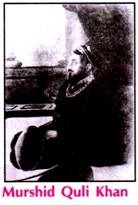
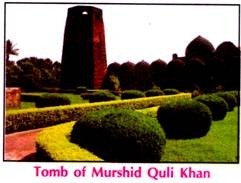
 Awadh:
Awadh:
The subah of Awadh comprised Benaras and some districts near Allahabad. Saadat Khan Burhan-ul-Mulk was appointed Governor of Awadh by the Mughal Emperor. But he soon became independent. He established a strong administration, crushed the power of the big zamindars and brought about law and order in the country.
His successor Safdar Jang gave Awadh a long period of peace and prosperity. The authority of the Awadh rulers extended up to Rohil-khand, a territory to the east of Delhi.
Mysore:
Early in the 18th century, Mysore was ruled by a Hindu king. After the death of the king, Hyder Ali captured the throne. Though illiterate, Hyder Ali was an efficient administrator. He became the ruler of Mysore when Hyder Ali it was a weak and divided state.
But within a short span of time he made Mysore one of the leading Indian powers. He modernized the army and expanded his kingdom through conquests. He was strong enough to emerge as a rival of the British.
The Rajput Kingdoms:
Taking advantage of the growing weakness of Mughal power, the Rajput states became virtually independent. But the Rajput chiefs continued to be divided as before. Most of the Rajput states were involved in petty quarrels and civil wars.
Raja Sawai Jai Singh of Amber (1681-1743) was a renowned Rajput ruler. He founded the city of Jaipur. He also erected observatories with accurate and advanced instruments at Delhi, Jaipur, Ujjain, Varanasi and Mathura. With the rise of the Marathas, Rajput influence began to decrease.
The Punjab:
It was under the leadership of Guru Gobind Singh, the tenth and the last Guru of the Sikhs that the community became a political and military force. The invasions of Nadir Shah and Ahmad Shah Abdali and the consequent decline of Mughal power gave the Sikhs the opportunity to rise. Between 1765 and 1800 they brought the Punjab and Jammu under their control. At the end of the 18th century Ranjit Singh, chief of the Sukercharia misl brought all the Sikh chiefs west of the river Sutlej under his control and established a powerful Sikh empire in the Punjab.

 The Marathas:
The Marathas:
Shahuji, the grandson of Shivaji, who had been imprisoned by Aurangzeb, was released by Bahadur Shah in 1707. The Maratha state at that time was ruled by Tara Bai, the queen regent. A civil war broke out between the two Shahu was victorious.
Shahuji appointed Balaji Vishwanath as his Peshwa or Prime Minister in 1713. Balaji Vishwanath concentrated all power in his own hands and became the real ruler of the Marathas. The king was relegated to the background. Balaji Vishwanath assigned separate areas to the Maratha sardars (chiefs) for the collection of levies of chauth and sardeshmukhi.
Balaji Baji Rao (1740-1761) further extended the empire in different directions. Maratha power reached its height under him. The Marathas soon reached Delhi and offered their support to the Mughal emperor. The expulsion of Ahmad Shah Abdali’s agent from Punjab brought the Marathas into an open conflict with Ahmad Shah Abdali.
The battle between the two forces was fought in Panipat in January 1761. The Marathas were completely defeated. Nearly 28,000 soldiers were killed. The Peshwa died in June 1761.The Battle of Panipat destroyed the possibility of the Marathas emerging as the strongest power in India. For the British, this battle was of immense significance. The Maratha defeat cleared the way for the rise of British power in India.
It should be noted that the Indian powers were strong enough to destroy unite it or to the Mughal Empire but not strong enough to unite it or to create anything new in its place. Possibly the Marathas alone possessed the strength to fill the political vacuum created by the disintegration of the Mughal Empire. But they lacked political vision and succumbed to British power.
